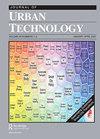分裂的流动性作为病毒载体:流动性正义和种族运动政治
IF 4.4
3区 经济学
Q1 URBAN STUDIES
引用次数: 1
摘要
Covid-19使基础设施分裂的潜在影响不言而喻,特别是在美国,这是20年前斯蒂芬·格雷厄姆和西蒙·马文首次发现的过程的结果。支离破碎的基础设施导致人们无法平等地使用安全的街道、公共交通、城市绿地、保持社交距离和远程工作,暴露出在风险暴露和脆弱性方面存在深刻的种族、民族和阶级差异。在支离破碎的基础设施背景下,不公平的流动性是导致美国SARS-CoV-2暴露率和死亡率存在巨大种族和民族差异的关键因素。这篇关于基础设施研究和关键流动性研究的交叉的简短评论认为,种族正义的观点提供了对多个地点和规模的不公正的实质的理解,这些不公正以如此不平衡和有害的方式形成了流行病。它以美国为背景,将美国历史上种族化的运动政治作为Covid-19大流行的核心。除了对支离破碎的城市主义的修复——或者是对普遍基础设施的梦想——大流行病的恢复需要流动性正义,作为一种对逃亡计划的重新编织,这种规划以common、Marronage和undercommons等批判性思想为代表。本文章由计算机程序翻译,如有差异,请以英文原文为准。
Splintered Mobilities as Viral Vector: Mobility Justice and Racial Kinopolitics
ABSTRACT Covid-19 has made self-evident the insidious effects of infrastructural splintering, especially in the United States, which are the outcome of the very processes first identified by Stephen Graham and Simon Marvin 20 years ago. Splintered infrastructures have left behind unequal access to safe streets, public transit, urban green space, social distancing, and remote work, revealing deep racial, ethnic, and class disparities in risk exposure and vulnerability. Inequitable mobilities within splintered infrastructural contexts are key contributing factors to the vast racial and ethnic disparities seen in SARS-CoV-2 exposure and death rates in the United States. This brief commentary on the intersection of infrastructure studies and critical mobility studies argues that a racial justice perspective offers an understanding of the materialities of injustice at multiple sites and scales that have shaped the pandemic in such uneven and detrimental ways. Focusing on the US context, it centers the racialized kinopolitics of American history at the heart of the Covid-19 pandemic. Beyond the unmaking of splintered urbanism—or a dream of universal infrastructure—pandemic recovery requires mobility justice as a reweaving of fugitive planning represented by critical ideas such as commoning, Marronage, and the undercommons.
求助全文
通过发布文献求助,成功后即可免费获取论文全文。
去求助
来源期刊

Journal of Urban Technology
URBAN STUDIES-
CiteScore
8.50
自引率
4.20%
发文量
42
期刊介绍:
The Journal of Urban Technology publishes articles that review and analyze developments in urban technologies as well as articles that study the history and the political, economic, environmental, social, esthetic, and ethical effects of those technologies. The goal of the journal is, through education and discussion, to maximize the positive and minimize the adverse effects of technology on cities. The journal"s mission is to open a conversation between specialists and non-specialists (or among practitioners of different specialities) and is designed for both scholars and a general audience whose businesses, occupations, professions, or studies require that they become aware of the effects of new technologies on urban environments.
 求助内容:
求助内容: 应助结果提醒方式:
应助结果提醒方式:


